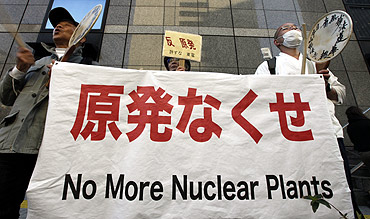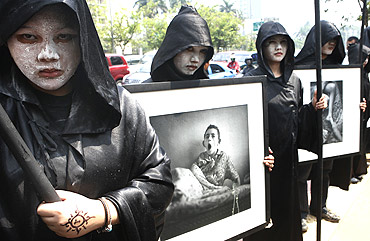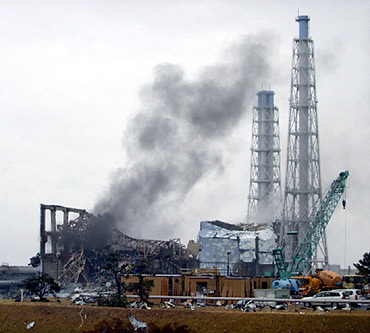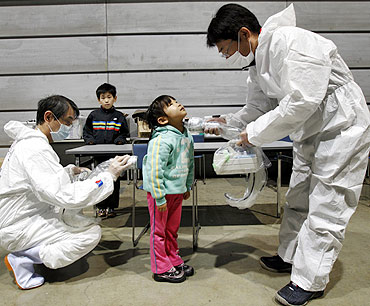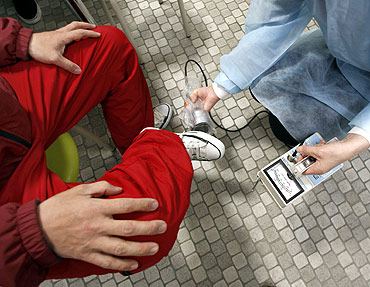 | « Back to article | Print this article |
Fukushima and Chernobyl: What are the parallels?
The Japanese government upgraded the severity level of the damage to the reactors in Fukushima to Level 7 from what was described as Level 5 three weeks earlier.
There is no higher level in the scale and the Chernobyl accident is the only one rated so high so far. Those who have been claiming from the beginning that the happenings in Fukushima are as dangerous as Chernobyl will find support from the Japanese assessment.
What indeed are the parallels between the two? An examination will provide some clarification.
The Chernobyl accident in Ukraine occurred in an operating reactor. It was caused by indiscriminate action by the operator and resulted in a sudden explosion within the core. The reactor was completely destroyed by the explosion and the prolonged fire that ensued swept most of the radioactivity in the core including the fuel itself high into the atmosphere spreading it far and wide. Station personnel fought the fire valiantly braving the dangerously high radiation levels and about 30 reportedly died in the process.Click on NEXT to read further...
In Ukraine, poverty made people return to contaminated areas
Evacuation did help prevent exposure to the radioactive cloud in succeeding days, but the delay in iodine tablet distribution led to high exposure to thyroid among children. The prevalent iodine deficiency in the region helped accumulation of radioactive iodine in their thyroid. Incidence of thyroid cancer among children increased after the accident.
There was extensive contamination of land around the reactor in Ukraine and the neighbouring Belarus. Poverty made people return to the contaminated areas in spite of the risk of radiation exposure. Significant levels were found in other countries further away. That did not warrant evacuation or relocation but restriction was imposed on consumption of meat and other food products.
It took several months to entomb the remains of the reactor in a structure called the sarcophagus, which is now crying for repairs or replacement by a stronger structure.No operator error in Fukushima, it's sheer fury of nature
Emergency cooling began but was disabled by the tsunami never to recover. Countrywide impact of the forces of nature denied vital electrical power to restore cooling, for nearly two weeks. An explosion occurred in four of the six reactors at site, but not in the reactor vessel. All of the fuel and much of the associated radioactivity remains in the reactor vessel.
The hydrogen explosions that occurred caused atmospheric release mainly of material in gaseous form like iodine and cesium. The releases came in puffs separated in time and were dispersed largely over the ocean.
Exposure to radiation may be small, but warrants analysis
Problems remain of large volumes of contaminated water accumulating on a daily basis because of leaks in the primary system. Uncontrolled discharges into the sea of contaminated water have occurred but are reported to have been stopped. Deliberate discharge of water with lower contamination level has also taken place. The contribution of these to exposure among the public may be small but warrants analysis. It would be a while before heat generation in the fuel in the core drops becoming more amenable to control.
Protective measures like moving people out of the vicinity of the plants were taken well in advance before the release of radioactivity. Iodine tablets were administered in good time. This has considerably minimised radiation exposure. In particular, measurements reported reveal that thyroid exposure among children is far below the conservative limits prescribed. Localised pockets of land contamination, higher than elsewhere, have been found in two villages.
Estimates are that even if people continue to live there for a year, they would receive minimal exposures well within the limits adopted by the Japanese. This allows time for clean up of the area before the residents can move safely back in.Magnitude of radioactive release in Fukushima far less than Chernobyl
The crippling of four reactors at the same time each contributing to radioactive releases is perhaps the only aspect that makes the Fukushima case seem worse than Chernobyl but the magnitude of release is far less to support that conclusion.
While the Soviet Union was determined to handle the Chernobyl accident all by itself, the Japanese have sought and utilised help from various quarters including the Russians.
The International Nuclear Event Scale was designed to provide a quick indication to the public of the severity of the event similar to the announcement of earthquake magnitudes. Subsequent analysis of the event can lead to upward revision of the severity in both cases.Unclear why Japan skipped nuclear alert Level 6
Without electrical power and fresh water, little could be done other than spraying seawater on the buildings and praying for lower temperatures. Meanwhile protective measures were implemented up to about 20 km. It was a clear Level 6 situation, but the authorities declared it to be Level 5 instead and that announcement came only on March 18.
With so much that seems to set Fukushima apart from Chenobyl, it is not clear why, after over three weeks, the Japanese have suddenly chosen to upgrade to Level 7 skipping Level 6. Have they and other countries that are helping them given up hope of retrieving the situation? That does not seem probable, but we will have to wait and see.
LV Krishnan is former director, safety research, at the Indira Gandhi Centre for Atomic Research, Kalpakkam.